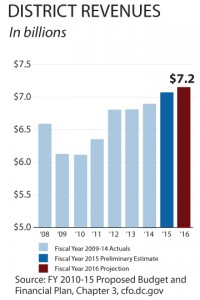The mayor’s first budget proposal is notable for making substantial investments in affordable housing and homeless services — despite facing a year when the city will not take in enough revenue to keep up with the rising costs of services. Mayor Bowser had to present a lean budget — finding significant savings across programs — in order to make a few significant new investments.
But the mayor may need to find new ways to pay for programs and services next year, including raising revenues. There is a shrinking number of places left to draw savings and there is likely to pent-up demand for services. Schools, for example, essentially got no new funding.
The mayor’s proposed budget of $7.02 billion from local taxes is about $25 million below the amount needed to maintain programs and services at 2015 levels, according to the Chief Financial Officer. The mayor avoided widespread cuts to services — while increasing funding for housing and homeless services — by scaling back a handful of programs and identifying operating efficiencies through the budget.
For example, the Department of Health Care Finance will get $703 million next year, despite needing $731 million to provide the same level of health services as in 2015.[1] Some savings will come from things like the federal government paying the full cost of a children’s health insurance program. But the mayor also cut reimbursements to hospitals — getting closer to national average rates. Even with these spending reductions, the agency would still be able to serve a growing number of Medicaid enrollees.
DC’s slowly growing revenues add to the budget pressures. The revenue growth rate since 2012 has been just about half the rate from 2010 to 2012 (See Figure). To counter this, the mayor proposed $36 million in new revenue, mostly from raising the sales tax from 5.75 percent to 6 percent. This is pretty modest, only one-half of one percent of the city’s budget.
The mayor’s budget shows that the District needs to make substantial new commitments to housing, jobs, and other needs to give all residents a chance to thrive. But with slowing revenue growth and an increasingly lean budget, the District will have to find new ways to pay for those commitments going forward. Cutting more funding could hurt progress if it means reducing services important to our quality of life — from libraries to roads to nutrition programs.
That’s why Mayor Bowser should look for new ways to raise revenue in the future — a strategy that will limit damaging cuts and do more to address poverty and expand economic opportunity for all residents. Given DC’s substantial income inequality — and the fact that taxes on DC residents are the lowest in the region — raising additional revenues from higher-income residents could go a long way to making the city a more equitable place.

